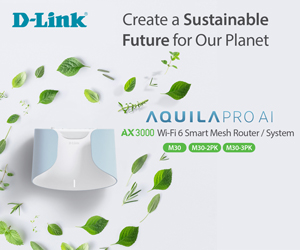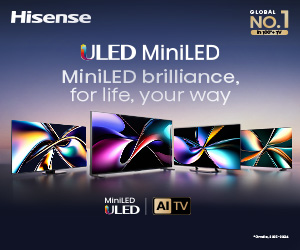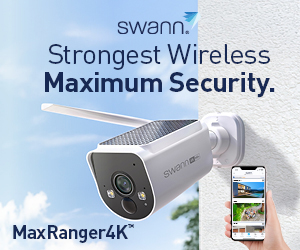The Hisense U8QAU is its best 2025 mini-LED TV in 65/75/85”, offers up to 5000 nits peak brightness and 4.1.2 Dolby Atmos sound by DEVIALET.
CyberShack spent a day reviewing this and the U7QAU, and we were impressed. Regrettably, we can’t give quite the full deep-dive review as these were not examined in our lab under controlled conditions, and we could not lug heavy and sensitive test equipment to the review site. Nevertheless, we think we have captured the essence and given you enough to compare.
The mini-LED/Quantum Dot versus OLED versus brand dilemma
Every year, mini-LEDs get better and brighter. Mini-LED replaces full-sized LEDs for Edge-lit (cheap), Direct-Lit (backlit, no local dimming), Full array with some local dimming, and Full-Array Local Dimming (FALD). Basically, mini-LED is the brightest backlight for an LCD screen.
It still uses the venerable LCD ‘gate’ technology, so it can’t quite achieve the inky blacks that OLED can. All LCDs suffer from blooming/haloing around moving white objects on dark backgrounds.
But as you can see later, solely from the number of zones (2048 versus 220 on the U7QAU), the screen refresh rate (166 vs 144Hz), the anti-reflective coating (pro vs standard), and finally, the processor (Pentonic 800 vs 700), mini-LEDs are not all the same. That goes for different brands, too.
For example, no Samsung TV supports Dolby Vision, the standard for home cinema movies. Sony and LG support DV, and like Samsung, they buy mini-LED panels from BOE (Hisense supplier) and CSOT (TCL-owned). It all comes down to the differences in operating systems, AI smarts (and data collection), manufacturers’ build quality, warranty, and marketing.
OLED uses WGRB pixel-level colours and lighting for natural colours and inky blacks. Quantum Dot (QD) uses different wavelength ‘dots’ excited by the blue mini-LED backlight to produce saturated RGB colours. But all QD is not the same. The higher the QD count, the more a panel costs. There is currently court action in the USA alleging that quantum dot technology is either completely missing from certain TV products or is present in negligible amounts that do not contribute to the colour performance. Marketing is marketing, and frankly, we don’t really care if it is QD or Phosphorus that makes colour. Anything above 90% DCI-P3 is pretty good.
All mini-LEDs struggle to balance brightness, colour accuracy, and contrast. It can be bright, but the colours are oversaturated, and the contrast (black levels) is greyer. Alternatively, it can have natural colours and better blacks, but the brightness is lower.
We have not seen all the 2025 mini-LEDs yet, but we can say that the 2048 zones in the 65” Hisense U8QAU have more successfully addressed the balance issue. However, in certain modes, the mini-LED overbrightens the image, causing black crush and loss of details. This can largely be cured by professional calibration, but it never reaches the image quality or price of OLED.
So, before you ask, the Hisense U89QAU is worth the extra over the U7QAU, but having said that, the latter is pretty good too. Its review is coming.
Let’s start with a comparison of the Hisense U8QAU and U7QAU.
The specs are based on the 65” size and correct as of 18/06/2025. Prices are RRP and exclude promotional or sales event pricing. Where the data is the same, it is left blank.
Note: This model is unique to Australia and cannot be compared to the Google TV U8QG version sold in the US or Europe.
| Hisense U8QAU | Hisense U7QAU | |
| Website | Product Page Quick Start | Product Page Quick start |
| Warranty | 3-years | |
| Price | 65/75/85” $2999/3999/4999 | 55/65/75/65/100” $1799/2399/3299/4199/7999 |
| Screen type | 55″ IPS-ADS, CONTRAST 2000:1 65″ VA, CONTRAST 5000:1 75″ IPS-ADS, CONTRAST 2000:1 85″ VA, CONTRAST 5000:1 | TBC |
| Screen | VA (65”) Direct LED (mini-LED Pro) 48-165 Hz 2048 dimming zones Anti-reflective Pro | ?? Direct LED (mini-LED) 48-144 Hz 220 dimming zones Standard anti-reflection |
| Bits | 8-bit + 2 FRC/1.07 billion colours DCI-P3 95% | DCI-P3 90% |
| Brightness | 700 Typical Peak (10% window with DV content) 5000 nits | 500 Typical Peak (10% window with DV content) 2500 nits |
| Contrast | 5000:1 static | Depends on the size and panel |
| SDR/HDR | HDR10/HDR10+ Adaptive/Dolby Vision IQ (DV) | |
| Processor | MT9655 Pentonic 800 ARM Mail-G57 MC1 | MT9618 Pentonic 700 ARM Mali-G52 MC1 |
| OS | VIDAA 9 | |
| HDMI 2.1 | 3 with VRR/ALLM | 4 |
| Wi-Fi and Ethernet | Wi-Fi 6E 2.4/5/6Ghz/Yes 100Mbps | Wi-Fi 5 AC 2.4/5Ghz/Yes |
| BT | 5.3 | 5.0 |
| USB | 1 x 3.0 and 1 x 2.0 USB-C Alt DP | Yes No |
| Other | Optical Out, Composite in | |
| 3.5mm headphone | Yes | |
| Sound | 4.1.2 90W with Room Tuning Left/Right front x 15W Left/Right side x 10W Left/Right up-firing x 10W Subwoofer 20W Dolby Audio and DTS | 2.1 40W Left/Right x 10W Subwoofer x 20W |
| Remote | Solar, not backlit | |
| Energy Star | 4.5 to 5, depending on size Maximum 250W but tended to be between 150 for SDR and 220 for DV | 5 Maximum 180W and from 120 for SDR |
| Size with desktop stand | 1488 x 914 or 954 x 290mm x 29.2kg 400 x 400 VESA wall mount | 1446 x 896 x 326mm x 20.7kg |
The key difference is (based on 65”) 2048 dimming zones versus 220, and peak ‘theoretical’ brightness of 5000 versus 2500 nits. The MediaTek Pentonic 800 processor is a premium SoC with a faster GPU and AI. The Pentonic 700 is slower and has a slower GPU.
In summary, the U8QAU has a better dynamic range, better reflection handling, and a substantial viewing difference.
Because we could not test nits, contrast, and DCI-P3, we have used test figures from the panel specifications. These figures could be different for the AU model.

First Impression – Deep blacks, vivid colours and very bright
I have reviewed most Hisense models over the past few years. Each iteration keeps improving, so Hisense is well past the cheap Chinese challenger brand.
The Hisense U8QAU is well-finished and well-made and should last the distance expected of brand-name TVs—at least ten years. That, however, is entirely dependent on VIDAA 9 TV Operating system updates and security patches.
It is an attractive package with aluminium bezels, a height-adjustable centre pedestal stand, a plastic back panel, and 4.1.2 sound with an imposing sub-woofer at the rear. At the bottom bezel is a power button/indicator, a microphone, and a mic on/off switch (for use with Hey VIDAA).
The power socket is on the right, and the AV sockets are on the left. There is no cable management system to allow for a flush wall mount. In any case, you need to leave room for the rear-firing woofer to bounce off the wall.
This TV, at out of the box at factory defaults, is noticeably ‘better’ than the U7QAU, but we are not here to compare because the latter was a 75” and using a different panel type.
You need to take care as the 65” and 85” use VA panels with a high 5000:1 static contrast (difference between the blackest black and the whitest white). The 55 and 75” use a BOE ADS Pro IPS, 2000:1 contrast screen. As we have not seen the ADS Pro screen, we cannot comment on whether it is better or worse. BOE make both types of screens and suggests that ADS and ADS Pro will eventually replace VA.
Remote – Pass
The solar remote has six presets, numeric buttons, a guide, and information. It is also IR and somewhat directional, but you can pair it with BT. It is not backlit.
It is relatively intuitive to use—home, back, input, settings, info, subtitle, mute, and microphone.

VIDAA U9
The biggest differentiator is that Hisense runs VIDAA OS versus Samsung (Tizen OS), LG (webOS) and TCL (Google TV). In 2019, VIDAA was hived off as a separate company to pursue an alternative TV OS. Its headquarters are in the USA, and its staff is in China, Israel, Poland, Germany, Slovenia, and the Netherlands.
VIDAA has two parts. The first is the TV firmware based on Linux. It handles setup and makes the TV work. It runs on Hisense (except in the USA, which uses Google TV) and Toshiba (owned by Hisense).
The second part is the content. The easiest way to describe VIDAA is that it is ‘app-less’, although, for simplicity, it calls them apps. Where other OSs require dedicated apps to be downloaded and installed from Netflix, Prime, etc., VIDAA accesses these via an HTML5 cloud browser. You can access the app-less library based on local copyright and licensing terms.
Because every bit of digital content comes via VIDAA, it offers universal search, content recommendations, free local and global advertising-supported TV (FAST), and central billing. Like all TV OS, VIDAA knows what you watch.
It offers various ways to set it up, including signing in with Google or Facebook (Do not use if you value privacy) or, as we prefer, using a junk email account (easy to set up in Gmail, etc.).
You must create a Hisense account to use smart TV features or VIDAA TV services.
The Home screen uses large icons, and scrolling down the rows offers recommendations, including Netflix, Prime Video, Disney+, etc. You can add from the VIDAA App Store, but you cannot delete pre-installed (paid-for) apps.
The VIDAA mobile application is available for Android and iOS (not tested).
Upside:
- Fast and easy to use
- It can be used as a semi-smart TV without a Hisense account (FTA and digital streaming)
- Offers Automatic content recognition and switching settings to suit.
Downside:
- It needs an internet connection for all smart TV functions (pretty much the same as any TV OS),
- Fewer ‘apps’ (buy a Google TV dongle if you need it).

Privacy – Pass
All smart TVs cover up what you view, information from profiles and cross-platform sharing with Google, Facebook, and others. So, Hisense knows about you and monetises that data (as do Samsung, LG, Sony, TCL, et al.).
You can turn off some advertising settings but still get recommendations (mainly adverts from Netflix, Prime, etc.).
As with almost all brands, we cannot cut and paste the privacy policy and terms of use for your education.

Hisense U8QAU ports – Pass
Note: Australian power frequency is 50Hz, so that is shown before the US 60Hz ratings
- HDMI 1, 2.1 (48Gbps) ALLM, VRR
- HDMI 2, 2.1 (48Gbps, ALLM, VRR
- HDMI 3, 2.1 (48Gbps) 4K@100/120/144Hz, ALLM, VRR, HFR and eARC/ARC switchable (use for a soundbar)
- USB-A 3.0 5V/1A/5W for external SSD drives (exFat to 2TB tested) and perhaps digital cameras
- USB-A 2 5V/.5A/2.5W (for flash drives)
- Digital Audio out (Toslink)
- 3.5mm 3-pole AUX in (RCA stereo connector)
- LAN 10/100Mbps
- 3.5mm 3-pole (no mic) headphone
- TV antenna
- Wi-Fi 6E AXE 2.4/5/6Ghz
- Bluetooth 5.3 SBC codec supports keyboard, mouse and gamepad and one BT stereo headphone or speaker.
If you are going to stream digital content, you need to use 5 or 6 Ghz. It requires a relatively strong signal strength router within 10m and at least 50/20 Mbps NBN; otherwise, you could experience buffering, image breakup, and possibly lost signal. Full-duplex Ethernet is the best connection for this.
As it does not support Chromecast, you will need a Google TV dongle for Android screen mirroring. It supports Apple AirPlay 2 (not tested). MiraCast for Windows PCs over Wi-Fi is at 1280 x 720 x 30fps, which is disappointing as most TVs now use 1920 x 1080 x 30fps.
There is a USB-C port (in the bottom right of the photo) that we did not discover until the review was done. It is not mentioned in any specs, but we suspect it is a USB-C 3.1 Gen 1 5 Gbps with ALT DP data, audio, video, and power. If this is the case, you could connect a computer or smartphone with a USB-C 3.1 or 3.2 Gen 1 or 2 and treat it as a monitor or for screen mirroring.

PVR – Not Tested
It can record FTA and digital TV channels to a USB (or SSD), not digital streaming channels. It uses the EPG to select +/-24 hours or set a scheduled recording. Recording is 1080p (or a lower native signal resolution).
Power use – Pass
Tests
- Digital and FTA approx. 150-200Wh
- Dolby Vision approx. 200-250Wh
- Standby screen off: <.5W
- At 40 cents per Wh, 8-12 cents per hour is negligible.
Voice control – Pass
It has dual mics on the TV (switchable) and a voice remote that supports VIDAA Voice.
Games – Pass+
The Hisense U8QAU has three HDMI 2.1 48Gbps with VRR, ALLM and HFR. 120/144/165Hz Game mode requires a Windows 11 PC with a suitable NVIDIA GeForce or AMD Radeon graphics card connected. Xbox X or PS5 can connect 4K@ 100/120Hz (not tested).
There is a game bar for instant feedback on gaming settings and features. 4K@60Hz input lag is <15ms and between <6ms for 4K/100/120.
This may be one of the lowest-cost TVs capable of good game performance.

Parental Control (not tested)
You can schedule blocking by time, channel, program or input port.
Accessibility (not tested)
Settings include Closed Caption, high-contrast text, text-to-speech, Talkback and more.

So, how does it look?
Joe and Jane Average will see a big, bright, colour-accurate screen that they can enjoy in SDR (FTA TV and digital TV streaming), HDR (digital streaming), and movies (Dolby Vision).
Videophiles will still see little crushing in dark areas, decent definition in the highlights and lowlights, minimal blooming, and few imperfections. It is a great panel.
It has the following SDR picture modes (HDR/DV is automatic)
- Dynamic: Maximum colour saturation affects Delta E accuracy. Best for very bright rooms.
- Standard: Colour and brightness for typical SDR News, Drama or Documentaries.
- Energy Saving: It can save energy and provide an acceptable image for darker rooms.
- Game: Optimises the TV’s settings on a PC or a game console connected to the TV.
- Sports: Optimises colours where there are large single-colour areas (like a playing field)
- Enhanced ARC: Adjusts for content automatically using viewer data, privacy implications.
- Filmmaker: As the maker intended, not very bright.
- Cinema: Closer to the DCI-P3 movie standard
Summary: Once set up, scroll through the presets to see what suits you. It is best to do this when you usually watch TV because the preset you like during the day may be too bright at night. We recommend Standard (or even Energy Saving with a few tweaks) for most viewing.
You may not be able to see the differences between the settings below, as you will likely view this on an 8-bit phone screen or desktop monitor. Look for details in the hair, green eye shadow, red lips and jewels. Also, look at the black background for subtle tone differences.
<Insert P>






Tests
We tested with SDR, HDR, HDR10, HDR10+ Adaptive, IMAX Enhanced, and Dolby Vision IQ content. All HDR content is automatically identified, and you can choose new presets.
Subjectively, and assuming a bright Aussie lounge room
- SDR (FTA and digital TV) on Standard or Energy efficiency modes exceeds expectations for daylight viewing.
- HDR/HDR10 (digital streaming) in Cinema or Filmmaker modes exceeds expectations.
- HDR10+ Adaptive uses the ambient light sensor and, in Filmmaker mode, meets average expectations, albeit not bright enough. It is way too tempting to ramp up the brightness at the expense of colour accuracy (our eyes crave saturated colours). We had problems finding much commercial HDR10+ content
- Dolby Vision IQ uses the ambient light sensor and meets expectations. Like HDR10+, it is tempting to select more colourful presets.
- Imax Enhanced is a remastering of HDR10+ and Dolby Vision content, but uses DTS:X sound and appears only to be supported by Disney+. It has not been tested, but we suspect this TV’s brightness and dimming zones suit Dolby Vision and Atmos more.
Colour – Pass+
It uses an 8-bit + 2 FRC (frame rate control) to produce 1.07 billion colours – all mini-LEDs use FRC. READ 8-bit versus 10-bit screen colours. What is the big deal?
DCI-P3 tests are 95% of the gamut, and Delta E is over 2 (could get this to <1 with professional calibration). The main areas to tweak are colour temperature and brightness. We tested using standard and dynamic presets.






SDR/HDR brightness (nits) – Pass+
- Sustained 100% Window: 769/785
- Sustained 10%: 3730/3298
- Peak 100%: 769/788
- Peak 10%: 3972/3469
While the 5000 nits claim is probably made under controlled conditions, this is pretty good and way more than you need for SDR or DV.
But everything in HDR is brighter than it should be.






Contrast – Pass
Contrast is the difference between the panel’s blackest black and the whitest white. This claims 5000:1 (test 4590:1), which is static contrast – a popular marketing term.


Blooming – Pass
Some fast-moving objects have minor blooming and leading-edge dimming. No LCD can entirely cure this.


Motion smoothing – Pass
As far as we can tell, it is a mix of BFI (Black Frame Insertion) for video up to 60Hz and AI predictive insertion (the difference between the actual frame and the subsequent frames and recognised shapes); ergo, there is some motion tearing and a little lack of sharpness at 60Hz or more. There are some minor artefacts around fast-moving objects.
Fast-moving objects don’t appear as crisp as we have seen.

Upscale – Pass
We test with 480/720/1080p content. In the most basic sense, it upscales to 4K (in 1080p’s case) by surrounding each real pixel with four more.
Hisense also has sufficient AI (from machine learning) to recognise specific objects and colours and use a mix of pixel wrapping and sharpening the image. It works well on 1080p. There is some loss of detail, but it is minor.





Off-axis viewing – Passable
All VA panels suffer from colour washout and colour shifts past about 120° (90° means sitting straight on). It is fine when sitting in front of the screen, but quite noticeable if sitting side on,

Reflection – Pass+
Compared to the U7QAU, it has a darker anti-glare finish that reduces glare and reflection. But like any LED, you need good back and side ambient light controls.

Colour uniformity and Dirty Screen effect – Pass
RGB colours are uniform, but we noticed some DSE around the edges in 100% white and grey tests
Sharpness and Text Clarity
It has acceptable text clarity to 24-point. Most OLEDs will get to 14-point.


PWM – Exceed
It uses PWM dimming, but it is at 20,000Hz, so it is safe for PWM-sensitive people.
How does it sound?
It has a 4.1.2 90W tuned by DEVIALET with Room Tuning. It decodes all standard formats and DTS.
- Left/Right front x 15W
- Left/Right side x 10W
- Left/Right up-firing x 10W
- Subwoofer 20W

Its presets include (these are all overridden by Dolby Atmos and spatial metadata or an HDMI-connected soundbar and its presets).
- Standard: Fairly flat neutral frequency
- Enhanced ARC: Automatically adjusts content, privacy implications
- Theatre: Tried to add more surround sound but failed with 2.1 speakers.
- Music: recesses mid to make the bass and treble sound more prominent.
- Speech: Recesses bass and treble to make 1-4kHz mid more prominent.
- Late Night: Focus on clear voice only – no bass or treble
- Sport: Attempts to reduce crowd noise and focus on commentary.
I wish I could say that it is excellent, but it is not a replacement for a decent Dolby Atmos soundbar.

| Deep Bass 20-40Hz | Nil, but distortion and white noise are evident |
| Middle Bass 40-100Hz | Linear build from 65 Hz to 100 Hz |
| High Bass 100-200Hz | Slow build to 1 kHz |
| Low Mid 200-400Hz | Choppy |
| Mid 400-1000Hz | Choppy |
| High-Mid 1-2kHz | Flattish with some frequency clipping to 6kHz |
| Low Treble 2-4kHz | As above |
| Mid Treble 4-6kHz | As above |
| High Treble 6-10kHz | Gradual linear decline to 18 kHz |
| Dog Whistle 10-20kHz | As above |
| Sound Signature type | This is a white noise test and pushes the speakers to their limits. It determines the native sound signature regardless of any EQ or presets. Bass: Enough mid and high bass but lacks low bass for any ‘room shaking’ effects. Mid: Choppy and clipped mid, not capable of full sound spectrum. OK for clear voice Treble: Adequate but can be harsh. High treble is not strong enough to give that feeling of ‘air’ – as if you were there. In short, it is fine for SDR TV, won’t excite you in movies and dull and thin for music. |
| Soundstage PCM stereo | It is as wide and high as the TV. |
| Soundstage DA/Spatial | It attempts to create a Dolby Atmos envelope, but it is very front-centric and not deep enough to reach the ideal seating position 3m away. |
| Comment | We expected much more from a Devialet-tuned speaker, but we noticed in the fine print that this feature is coming through a software update. The update release time varies by model and region. In any case, if you are watching movies with any surround or spatial sound, buy at least a 7.1.4 soundbar. |
| Read | How to tell if you have good music – sound signature is the key (AV guide) |
CyberShack’s view – The Hisense U8QAU is a stellar SDR and well above-average HDR/DV TV.
It is nice to have both the 65” U8QAU and 75” U7QAU simultaneously for review. I reviewed the U8NAU first, and overall, it is a good viewing experience, adding more value and features than expected for the price. It is way ahead of the generic Chinese brands – way ahead!
As we said earlier, it is not a shootout, but if the U7 is fine for the average Aussie lounge, then this is better.
I enjoyed looking at SDR and HDR/DV content. While mini-LED will never match OLED for pure black and white (which videophiles demand), this is an acceptable compromise, especially for use in bright areas.
TV sound is not a strong point for any brand, and Hisense is no exception
Competition
We have not seen the 2025 mini-LED competition yet. Its only competitor is TCL.
The U8QAU competes with the TCL C8K (successor to the 2024 C855). Hisense has more dimming zones.
Hisense U8QAU ratings
- Features: 85 – everything you could want from a premium mini-LED
- Value: 85 – Looking at the alternatives, it is well in the ballpark.
- Performance: 90 – Reasonable out-of-the-box calibration and presets, meaning Joe and Jane Average can plug and go. It can be improved by professional calibration.
- Ease of use: 80—VIDAA 9 does everything you need in a relatively easy-to-use interface. If you need more streaming Apps, buy a Google TV dongle. While it has a three-year warranty, the single OS upgrade loses points against the competition, generally between four and seven.
- Design: 80 – A little chunky; wall mounting may impact speaker fidelity.
Hisense U8QAU, Hisense U8QAU, Hisense U8QAU, Hisense U8QAU, Hisense U8QAU
CyberShack Verdict
Hisense U8QAU pro-grade Mini-LED TV
65/75/85” $2999/3999/4999











Comments